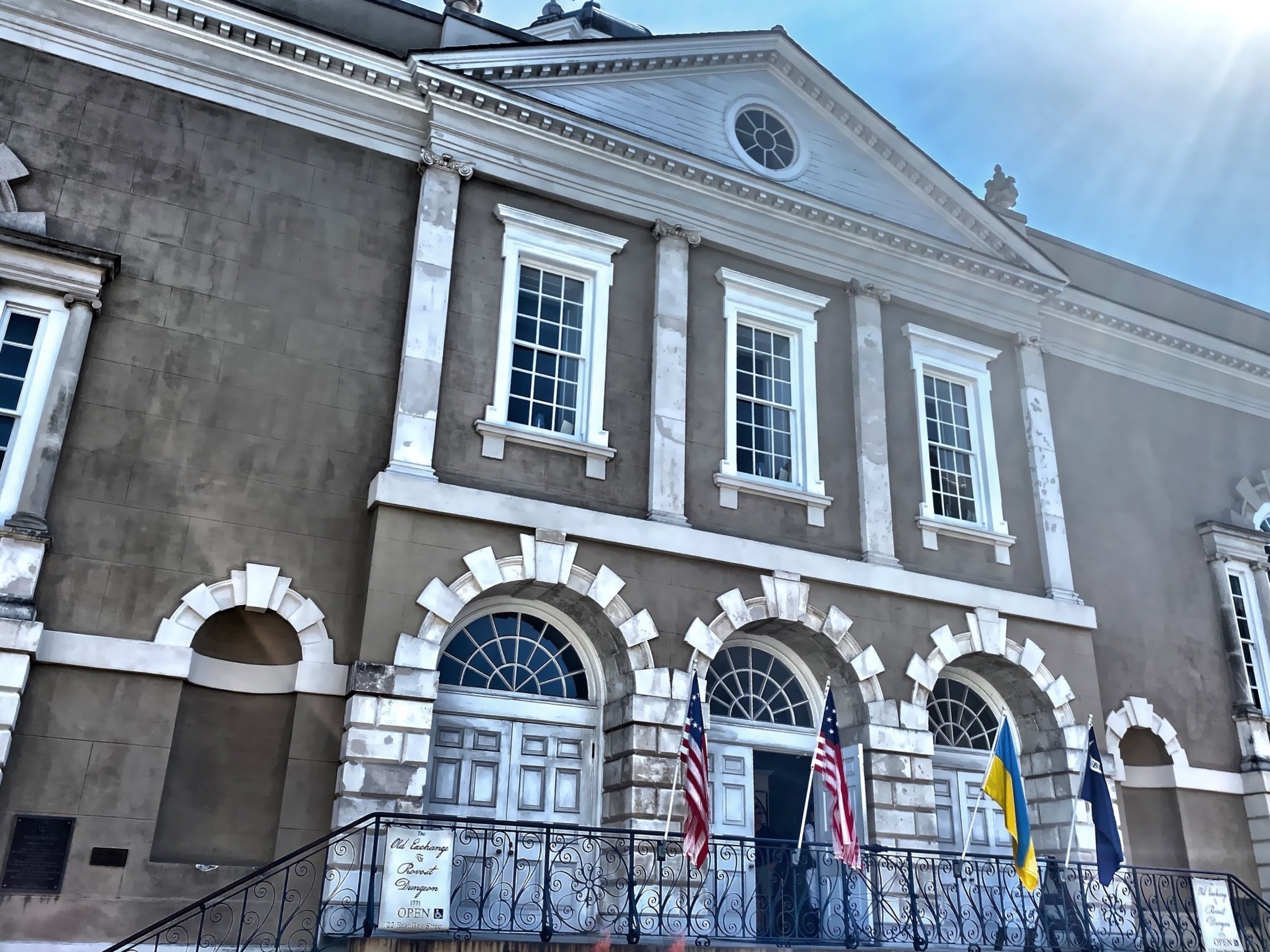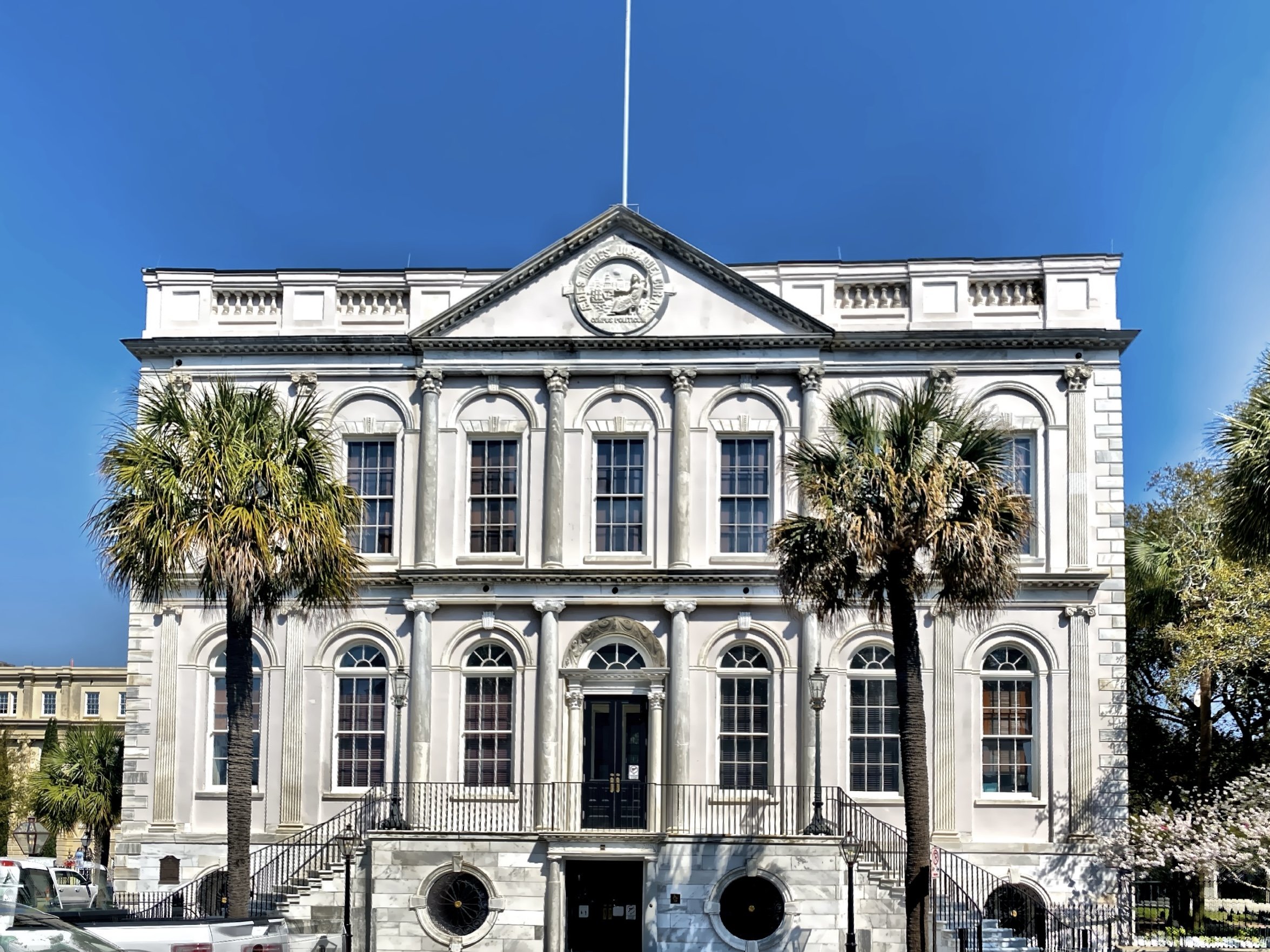A Southern Living Museum - Charleston, SC
Charleston was founded in 1670, and became one of the wealthiest cities in the Colonial and Antebellum era, mostly on the labor of enslaved people. Today it is defined by its cobblestone streets (there are still eight), pastel painted homes, palmetto trees, hitching posts, historic landmarks, and the elegant antebellum architecture of The Battery. Explore streets with names like Broad, Church, King, Queen and quiet streets and network of alleyways. Get lost in the picturesque and preserved Charleston, a city with a long history. It was the home of the first public college, museum, playhouse and golf club and it is where the first shots of the Civil War rang out. Walking is the best way to experience Charleston.
This is what caught my eye; I hope you enjoy it!

Preserved architecture

You may want to hit Poogan’s Porch for some good southern cooking, a cocktail, and maybe a ghost sighting.

A colorful sunset at Brittlebank Park

A walking tour is the best way to see the city
Do you like the images posted?
Click here to explore the shop.
The origins of the ‘Charleston’ dance has its roots in the African community here in Charleston. It was usually done without music and just clapping.

Some of the beautiful homes on The Battery, the area where Stephen Colbert grew up.

.

.

.

.

.

.

This statue of William Moultrie, a General in the American Revolutionary War, stands in White Point Garden.

The Thomas Rose House on Church Street was built in 1773.

The medallion to the right of this gate is the Carolopolis Award which is issued by the Preservation Society of Charleston established in 1953. The award recognizes extraordinary private and public efforts to maintain the historic character and authenticity of Charleston and the Lowcountry.

The Charles Drake House was built in 1890

Creeping fig grows on the stairs

Grave markers in a small overgrown cemetery

Charleston historic homes were built with an airy porch that included a hospitality door. The doors were a helpful sign to neighbors and friends. If the door was open, it meant the residents were welcoming guests and a closed door meant ‘do not disturb’.

Public art on Queen Street

Interior images from St. Michael’s Church

.

This ornate wrought iron entrance gate of St. Michael’s Churchyard was created by German-born forger J.A.W. Iusti.

Inside St. Michael’s Churchyard

.

.

The South Carolina Society Hall was built in 1804.

The sun setting on the city

.

The Cathedral of Saint John the Baptist opened in 1907.

The Dock Street Theater in the French Quarter first opened in 1809. The original Dock Street Theater, probably destroyed during the Great Fire of 1740, was the first structure in America built just to be used for theatrical productions.

The beautiful architecture of the Dock Street Theater entrance

Inside the Dock Street Theater

The Old Slave Mart Museum tells the story of Charleston’s role in the domestic interstate slave trade from 1856 to 1863. This building was constructed in 1859, and is believed to be the last slave auction facility in South Carolina.

If you look closely at some of these bricks, you will see the enslaved workers’ fingerprint that created the bricks.

I was told this home was renovated by singer Daryl Hall

The Pineapple Fountain is the focal point of the Charleston Waterfront Park, opened in 1990.

Looking off the Waterfront Park Pier

Historic cobblestone streets are still in use

Back in the 1800’s these buildings were warehouses which helped to fuel commerce in Charleston’s harbor. In the 1950’s these buildings were renovated into residential homes.

.

.

The Sottile Theater on King Street opened in 1927 as The Gloria Theater. It was built by Albert Sottile’s Pastime Amusement Company as was designed as a smaller version of the great movie palaces of the era.

A colorful gallery on E Bay Street

‘Rainbow Row’ is a series of 13 brightly-colored houses dating back to the mid-18th century. In 1931, Judge Lionel Legge and his wife, Dorothy Porcher Legge purchased a house on East Bay Street and painted it pastel pink. Neighbors followed their lead.

The United States Post Office and Courthouse was built in 1896 and is on the National Register of Historic Places.

Folly Beach on the barrier island

A historic city fire watch tower in the middle of the city

A sculpture of a Dalmatian lays out in front of the Charleston Fire Department Engine #2 building on Meeting Street.

Sullivan’s Island at the mouth of Charleston Harbor

Catfish Row was not always the cheery site it is today. A century ago it was a former home of slaves. Back then it was know as Cabbage Row. Author Edwin DuBose Hayward, a struggling writer working on his first novel, “Porgy”, lived just down the street.

.

Alleys are prevalent here and you will see homes like this hiding behind brick and wrought iron.

1 Broad Street was completed in 1853

Shutters and flower boxes

Market Hall was built in 1841 for the use of the commissioners of the market and was also used as a meeting hall. The hall was the commercial center for many years and a recruiting station during the Civil War.

Washington Square Park

The whimsical homes lining Church Street

.

.

.

.

A former enslaved home transformed

The First Baptist Church of Charleston was completed in 1826.

This corner house on Stolls Alley shows the many layers of construction.

#17 and #17 1/4 Chalmers Street. The Pink House (#17) is one of the oldest structures in Charleston.

The French Huguenot Church was built in 1884

A sunset at Shem Creek

The Charleston Museum has local historical artifacts.

The spiral staircase in the Charleston Museum

The Old Exchange and Provost Dungeon was built in 1771 as commercial exchange and custom house.

Built in 1801, the Charleston City Hall at Meeting and Broad Streets is one of the noted ‘Four Corners of Law’, at this historic intersection. Occupying the other three corners are the County Courthouse, the U.S. Post Office and St. Michaels’s Episcopal Church. Each corner represent a different branch of law: city, state, federal and ‘God’s law’. The phrase ‘Four Corners of Law’ was coined by Robert Ripley of Ripley’s Believe or Not.

St Phillip’s Church was built in 1836

Inside St. Phillip’s

The Mills House Hotel was originally built in 1853 by grain merchant Otis Mills. The condition of the building fell into decline and had to be demolished, when it was discovered that it could not be salvaged. This is a replica, built in 1968, of the original building.

The Circular Congregational church was founded in 1681 and is one of the oldest continuously worshipping congregations in the South.

Front porch hospitality

The walkway along the Battery

What you should know:
Public restrooms are available in parking garages , parks and public buildings (such as court house, city hall). You can pick up a “Downtown Charleston Public Garage & Restroom Guide” at the Visitor’s Center.
On the street parking is available, some metered; check posted parking regulations signs. There are also paid parking garage options.
There are many restaurant options.
This is a walkable city, and it is a great way to get around and see the city up close.
People are friendly and helpful.
You could spend a day to a couple of days exploring the city.
Book a walking tour. I recommend Two Sisters Tours.
For more information: Charleston, SC



